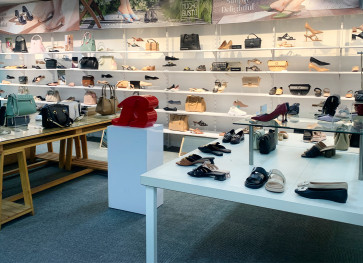Factory art feeding families
Appropriation: Even indigenous Australian dot painting methods have been appropriated by Baliâs commercial art market
Change Size

A
span class="inline inline-none">Appropriation: Even indigenous Australian dot painting methods have been appropriated by Bali's commercial art market. Ajui painstakingly creates a painting a day.
Despite churning out several paintings a day, pak De does not consider himself an artist.
Like many other painters in Bali, he creates what he sees as almost factory art ' wall furnishings to brighten up a dark corner of a home or to hang on a wall by the dining table.
A wood carver by profession, De moved from his home town of Jember, East Java, 17 years ago, hoping for a better life.
In Jember, wood carvers worked as day laborers, their skills with chisels in teak not valued highly, he says. 'I moved here to Bali and changed from wood carving to painting. I was surrounded by painters and I saw you could make a better living from paintings.'
'I am self-taught,' the 42-year-old says while seated on a tikar mat in his studio in Tengkulak. 'I am not an artist, but a commercial artist. A fine artist that is in a very different and a very difficult profession.'
De is surrounded by several oil paintings in various stages of completion.
Working as a commercial artist has given him freedom, De says ' and it is work that has not at all been affected by his disability.

'I got polio when I was a small child. It does not bother my work at all,' he laughs when talking of his right leg, which was wasted by the crippling disease.
Each week, De creates a dozen works that sell from US$12.50 to $15, which he says is enough to raise his family and pay for the needed canvas, stretchers, paint ' he says he uses locally produced oils to cut costs ' and turpentine.
'Lots of art shops sell my work. They sell them and we re-stock every week,' De says. 'I have five designs. Some of these are my own idea, others I have copied. I would of course love to make real art, but I don't have the money for that. As a commercial artist on the other hand, you can sell cheaply and make money.'
De considers his mass production of paintings, which at peak times means making designs with stencils and then filling in the colors like on a factory line, as far better than working for a boss as a day laborer.
'This is not the life of an artist, it's more like a factory, but I work from home and I am using my skills, so it's a good life,' he says.
His young wife, Suryatin, helps out in the studio and makes her own paintings of characters from the Finnish video game Angry Birds. She completes around five paintings a day, selling them all for a couple of dollars or less.
'When I met pak De, I was just playing around with art,' says the 29-year-old mother of two. 'Then I studied under him and now I help in the studio and make the Angry Birds. Together we have made a great business in commercial art.'
Suryatin continues. 'Sure it can get boring, painting the same things over and over again, but that's life.'

A few kilometers from De's studio, another commercial artist is hard at work in Batuan, pumping out portraits of Buddha heads that sell like hotcakes.
Sumedi Tjipto Wardojo, nicknamed Didi, is so used to painting the Buddha's head that his hand virtually works on automatic pilot.
With a large brush, he uses white acrylic paint to shape the lid of Buddha's heavy eyes with a single stroke. In a flash, the Buddha's face is brought to life.
Didi moved from Surabaya to Bali on the cusp of the millennium to work in advertising.
However, by 2004, he had picked up a brush and started a career in commercial art.
'I started to teach myself to paint. I was living in Canggu at the time and tried to sell my works. Then in 2007, I moved here to Sukawati, because people coming here wanted to buy my paintings of the Buddha. That is my best seller. I paint around 100 of these canvasses each week. These sell for $3.'
'I use a stencil for the Buddha's eye, and that speeds the process. I can make 12 paintings a day. My hand has done this so many times, it is automatic,' says Didi who also paints portraits using a projector.
For that technique, an image is projected onto a canvas and the outlines are traced, creating the foundation for the portraits that are then colored in an almost dot to dot method.
On his studio's walls, hang Marilyn Monroe, Bob Marley and, ironically, the sharply mustachioed artist Salvador Dali, along with family group portraits occasionally ordered from Didi.

Legendary figures like Marley and Monroe are the best selling works created through the projector art technique, says Didi, who, like De, does not claim to be an artist.
'I never sign my work, because there are too many of them and this is not fine art,' Didi says. 'I see myself as a commercial artist. If I was ever well off, I might try to create fine art, to have exhibitions. Of course, I have that dream, but this work ' commercial art ' is a way for me to find the money we need as a family.
He adds that he could never have done this type of work back home. 'There is not a lot of art in Surabaya. I could not live like this there ['¦.] people come to Bali to buy art as souvenirs, so many Javanese artists make their paintings in Java, then bring them to Bali to sell. So people buy works from Java in Bali and then take them back there.'
An art trader, Rini, arrives at De's studio on a motor bike with her five-month-old baby girl and 60-year-old husband and artist. She is making the rounds of several studios on a scorching day.
The job, which Rini said that she has done since leaving Surakarta, Central Java, 20 years ago, shows a tougher side of the market that has supported and given freedom and opportunity to many commercial artists.
'I collect works from the artists and sell them to art shops, galleries and the big industrial painting stockers. I take a 10 per cent commission on works that I buy for $10. The art shops sell them for $100,' Rini said.
'Most days I find I am losing money, but there is no other job I can do.'


' Photos By JB Djwan









